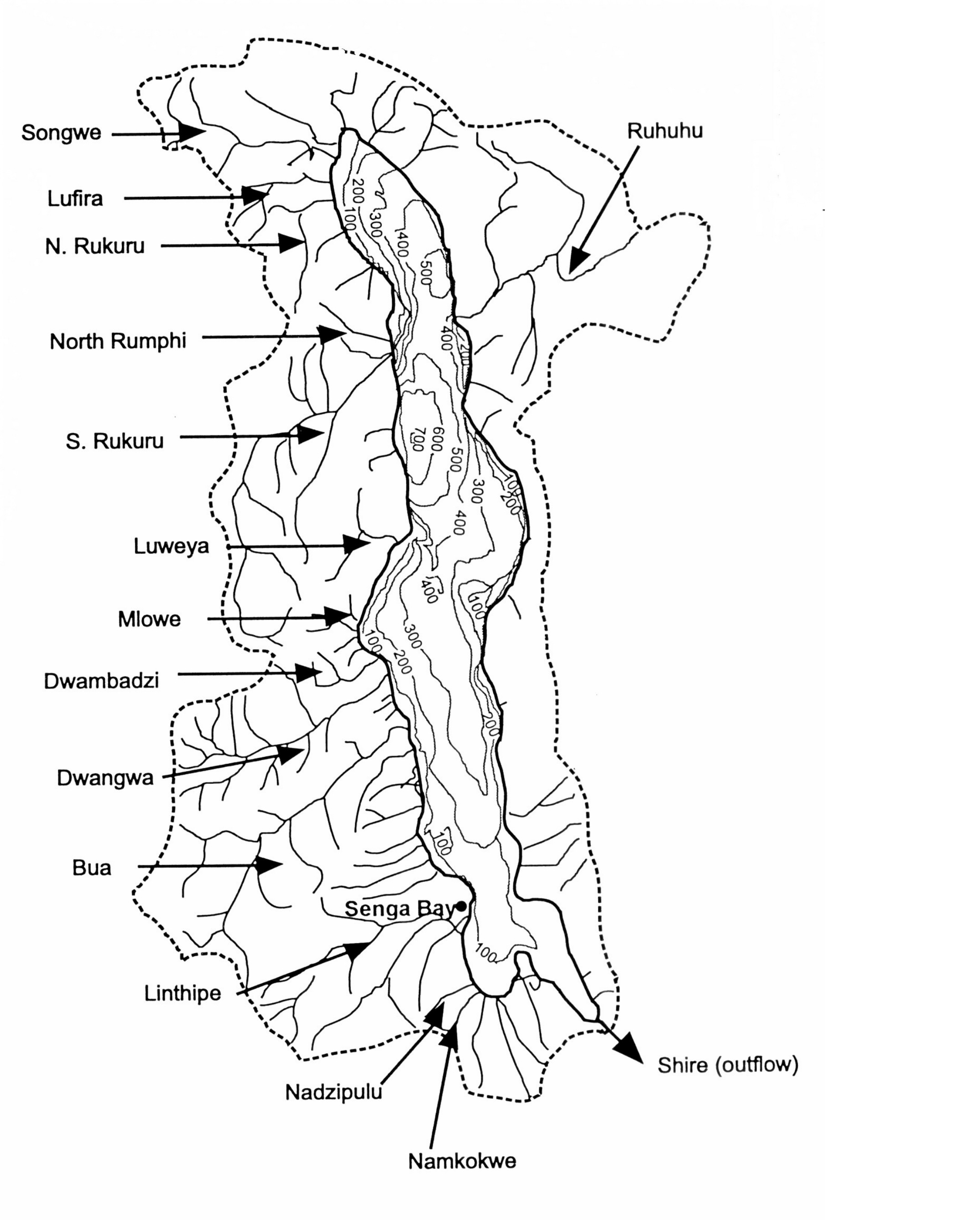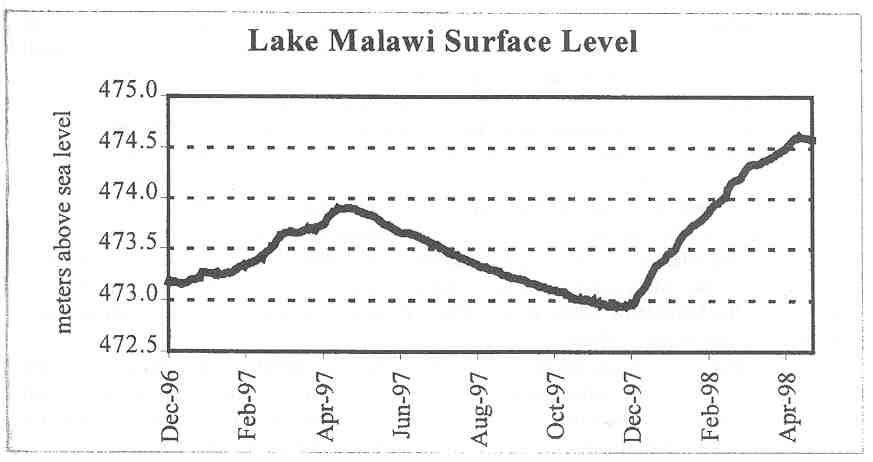


 |  |  | 20.6 Particular eutrophication issues to consider for Lake Malaw |
The major sources of nutrients such as N and P to Lake Malawi are rivers (Figure 6) and atmospheric deposition [53]. Almost all silica entering the lake comes from its tributary rivers. For the epilimnion, both rivers and vertical mixing are important silica sources.

River inflow responds to climatic variability and exhibits large shifts in runoff. The rainy season experiences large inflows, while in the dry or winter season the inflow decreases strongly. The lake surface levels also follow this pattern (Figure 7). This may also magnify the loading of nutrients and sediments, especially from river basins with extensive deforestation and agriculture. The annual precipitation regulates for the annual variability of inflow. This is also the case with the runoff and nutrient loading in other lakes or enclosed seas e.g. the Baltic Sea [477].

A comparison of the 1997 loading with previous estimates of Lake Malawi (Table 2) clearly indicates that river loading may play a much more significant role in nutrient loading to the mixed layer of the lake than previously thought. Bootsma and Hecky [53] reported that sediment and sediment-bound nutrient load is higher in the lake through rivers, which are heavily impacted, (Linthipe, Songwe and Dwangwa Rivers) than rivers that are lightly impacted (Mlowe, Luweya and Dwambazi Rivers). See Figure 6. The Linthipe, Songwe and Dwangwa Rivers are heavily impacted because of intensive land-use practices in their catchments. The catchments are characterised with more agricultural activities (e.g. intensive sugar plantation along Dwangwa River) and deforestation, and greater population densities compared to catchments of the lightly impacted rivers. Besides, such rivers are heavily impacted because of topography, urbanisation and improper sewage treatment and disposal (e.g. direct disposal of sewage and industrial waste into rivers). When industries dispose their organic waste, the biological oxygen demand (BOD) can be higher than the recommended (20 mg l-1 for the treatment works and 5 mg l-1 for the stream), [11]. The levels of ammonia detected in the receiving waters of Lake Malawi from ethanol effluents are reported to be above the recommended levels for most species in water, ranging between 0.6 to 2 mg l-1 [325]. Even the management of clinical waste seems to be a problem in Malawi. In several basins such practices can alter the patterns of river nutrient/sediment transport. Hence the dilution capacity level of the lake's large water volume may no longer be effective.
| 1997 estimate | Previous estimate | |
| Total dissolved phosphorous | 1.195 | 1.51 |
| Suspended phosphorous | 9.08 | 1.91 |
| Total phosphorous | 10.28 | 3.42 |
| Total dissolved nitrogen | 22.87 | 23 |
| Suspended nitrogen | 178.6 | 12 |
| Total nitrogen | 201.5 | 35 |
| Soluble reactive silica | 298.8 | 220 |
According to Bootsma and Hecky [53], a larger portion of atmospheric carbon and N deposition in the lake is in the form of soluble organic compounds. Soluble and particulate P deposition is similar in magnitude, with much of the soluble P being organic. Atmospheric deposition of nutrients in to the lake surface is primarily in the form of dry deposition. For instance, mean daily dry deposition is almost twice the mean daily wet deposition (Table 3). This may be due to less dust during the rainy season, when the ground is wetter and there is greater vegetation coverage. It is also reported that concentration of solute and particulate nutrients in rainwater near Lake Malawi are not particularly high relative to industrial regions or some other parts of Africa. However higher than average NH4+, NO3-, and K+ concentration, suggests that burning is having a significant effect on atmospheric chemistry around the lake. High P deposition may also be linked to burning practises. But although the direct effect of the deposition of these solutes on the lake may not be negative, the burning and soil exposure is. These observations may potentially result in negative impact, such as siltation, accelerated flux of nutrients from soil to the lake, and a decreased and a more variable water supply from rivers as described above.
| Total C | Total N | Total P | Total Si | |
| Mean Wet Dep. (µmol m-2 event 1997/98) | 2465 | 431 | 14.2 | 115 |
| Mean Dry Dep. (µmol m-2 event 1997/98) | 2570 | 560 | 24.7 | 155 |
Nutrients are renewed in the photic zone of Lake Malawi by vertical transport from the nutrient-rich deep waters. However, most of the time the algae are experiencing balanced growth with their biomass limited by grazing and adequate nutrients supplied through regeneration. The algae community in the lake is adapted to a low, but relatively steady supply of nutrients supplied through the mechanisms of regeneration by grazers and continuous introduction of nutrients from below the epilimnion by mixing. Conducting nutrient enrichment experiments, Bootsma and Hecky [53] revealed that if nutrients increased in Lake Malawi, chlorophyll a concentrations would increase too and algae species composition would change. Further evidence was seen during January and February (rainy season when the river runoff increases) in the Linthipe River, which is one of the most nutrient suppliers to the lake. With increasing nutrient loading of P relative to N, the algae community was affected and the chlorophyll a concentration increased. As such it is likely that increased P input to the lake, due to increased erosion, will disrupt the balanced algae growth and favour the development of N fixing, filamentous cyanobacteria such as Anabaena species. Anabaena blooms were observed in the southern portion of the lake in March and April of 1997 and 1998 [53].
There have been quite a few changes in the quantitative phytoplankton flora of Lake Malawi, which creates concern, besides the fish kills reported now and then due to probably ethanol effluents spillage, pesticides and some chemicals from the Sugar Corporation of Malawi-Dwangwa Mill into the lake. Usually there are fish kills due to pesticides and herbicides when knapsacks sprayers are washed or cleaned in the water courses (per.comm). The filamentous chlorophytes of the Mougoetia/Oedogonium complex has occurred since the 1960's, but it has been ignored until now. Planktolyngbya tallingi has been reported to be appearing in the southern portion of the lake, where it has replaced the dominant species, Planktolyngbya nyassensis. This is an indication for increasing nutrient availability and poor light conditions. The filamentous blue-green alga, Cylindrospermopsis raciborski, which has toxic forms, has also been reported. This is of concern because usually such algae are typical climax species in highly eutrophic situations. Anabaena species blooms are currently reported to be reoccurring, especially inshore in the vicinity of the Linthipe River, during the end of rainy season (March-April). In the past this species was reported to occur only in October-November. The co-occurrence of the dinoflagellates Peridinium species with the Anabaena species bloom in at least one bloom is also worrisome as both taxa have forms, which can produce toxins (Bootsma and Heckey 1999). Even if such changes in the phytoplankton community composition may yet appear minor, they are indications that greater changes may follow. Due to fragmentary, qualitative and discontinuous availability of earlier studies, the interpretation of data is difficult. It could just reflect natural variability. In Lake Victoria qualitative analysis of phytoplankton did not occur until after dramatic changes had occurred. By then the phytoplankton community had changed within decades to a eutrophic assemblage dominated by potentially toxic blue-green algal species [326].
 |  |  | 20.6 Particular eutrophication issues to consider for Lake Malaw |